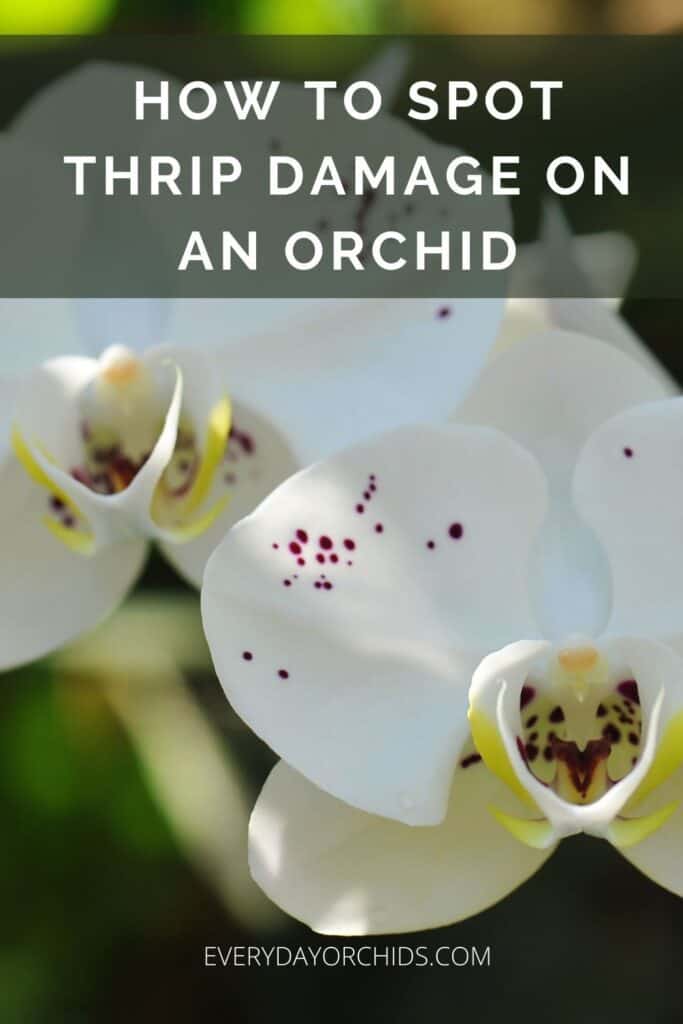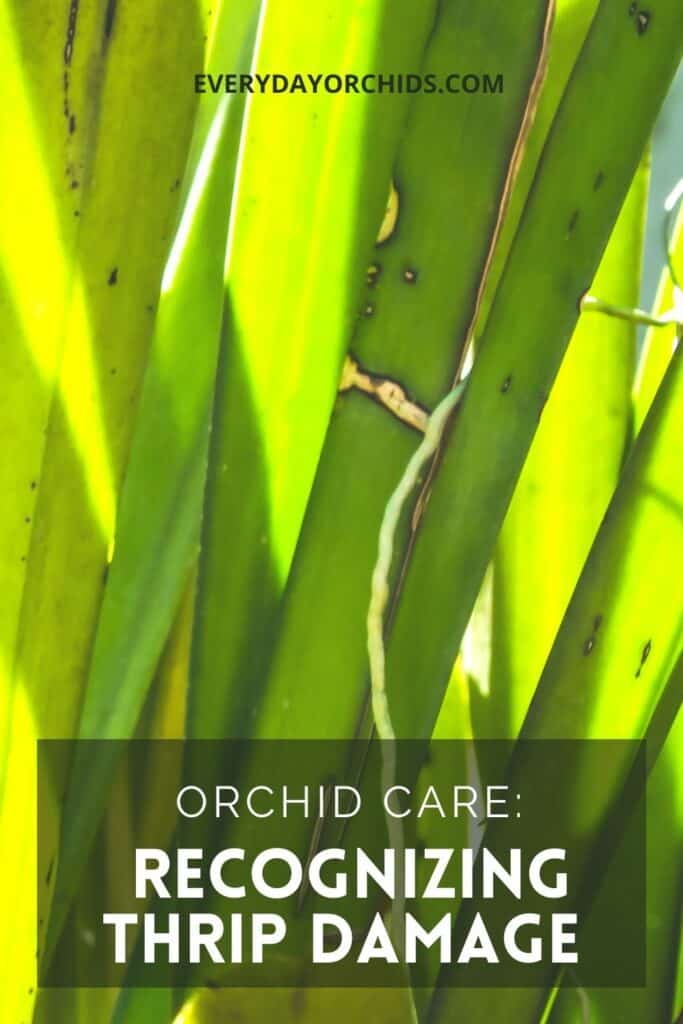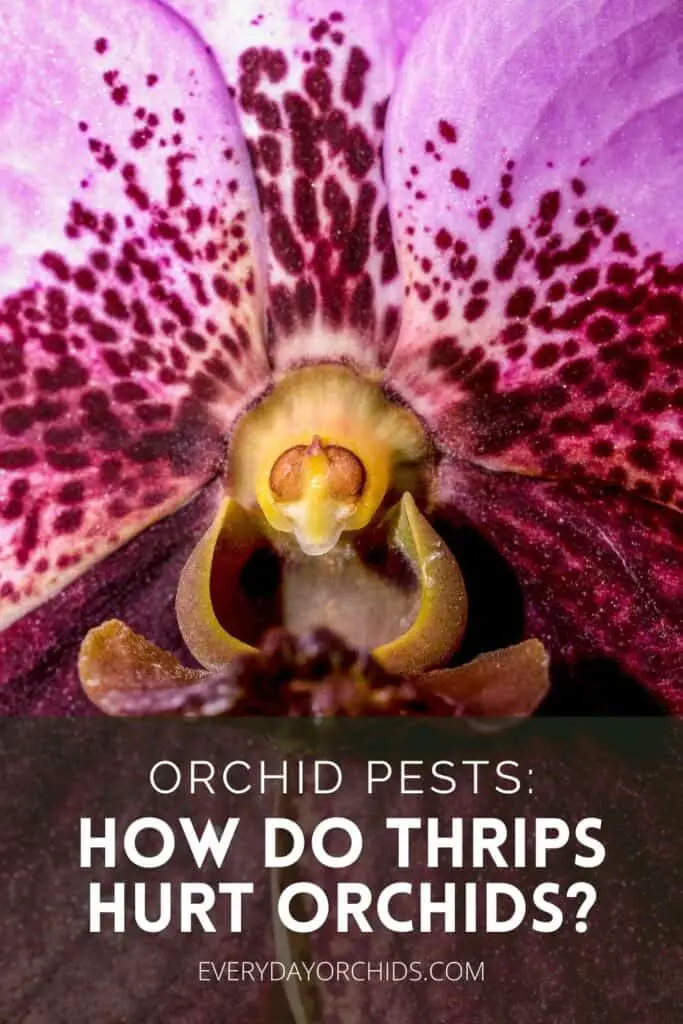Thrips are one of the more common orchid pests known to orchid growers. Unfortunately, these pests are hard to spot. By the time orchid growers realize they have an infestation underway, thrips have already caused significant damage to the plant. Oftentimes, it is this damage that alerts growers to the presence of thrips.
Thrips damage orchid flower buds and new growth, whether that new growth may be a leaf or a root. Both larvae and adult thrips will feed on the plant. Thrips can also spread disease, such as viruses, from plant to plant, so watch out for that as well.
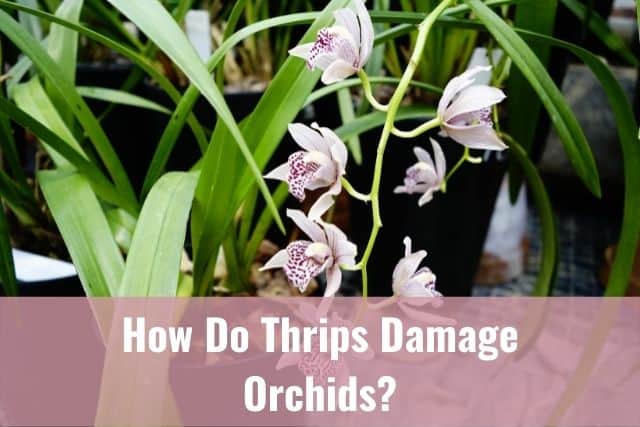
Recognizing thrip damage on an orchid is key to first identifying a thrip infestation. In this article, I’ll go over what parts of an orchid are targeted by thrips. You’ll also learn what kind of damage you can expect to see when you have a thrip infestation. Keep reading to learn more.
Please note that these links are affiliate links and as an Amazon Associate, I earn from qualifying purchases. Purchases made through affiliate links in this post may generate commissions at no additional cost to you. Use this link for a discounted Amazon Prime trial. Thank you for your support!
Table of Contents
Thrip Damage To Orchid Plants
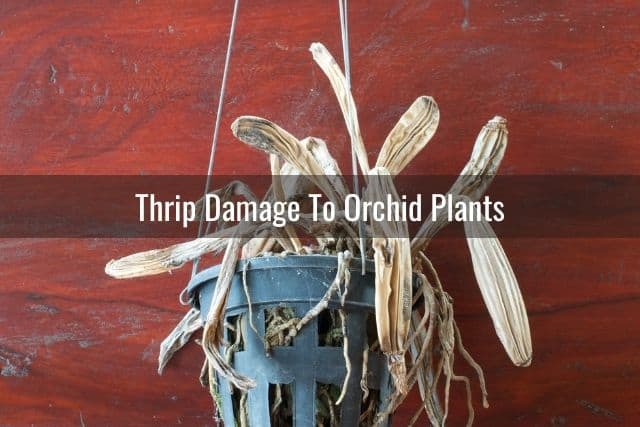
Thrips can damage an orchid by using their mouthpieces to suck sap and nutrients from the plant. They can attack many types of plants, including orchids. As mentioned earlier, thrips primarily target new growth and flowers.
Thrips feed on young orchid leaves, root tips, flower spikes, flowers and flower buds. As such, these are the primary areas on the orchid where you will see thrips clustered during an infestation. I’ll go into more detail about each area below.
In addition, thrips are also able to spread disease between plants. This is in part because these winged pests move easily from plant to plant.
Thrip Damage To Orchid Flower Buds And Flowers
Buds and flowers are the thrip’s favorite part of the orchid to feast upon.
If the thrips have attacked the flower buds, the buds will fail to open. Essentially, you will see bud blast occur even if you have protected the orchid from the more common factors that cause orchid flowers to fall off early.
If bud blast doesn’t occur and the flowers end up staying on the spike and opening, the thrip damage will still be apparent. You’ll see browned, wilted edges on the flower petals.
There may also be some spotting, streaking, discoloration or blemishes on the petals. This is due to the thrips sucking out the juice from the flower buds in spot locations.
Blowing gently into an open flower will result in a flurry of insects crawling or scattering about. You can also gently tap the open flower over a piece of white paper. If you see any tiny dark insects fall out and start crawling around on the paper, those are likely going to be thrips.
For some deeper reading on how to find and dislodge thrips from orchid flowers, check out this article.
Thrip Damage To Orchid Flower Spikes
Flower spikes will wither and shrivel up, beginning at the point of infestation all the way to the end of the spike.
Any flower buds along the spike will also wither and die. This is due to the thrips sucking up all the sap and nutrients from the flower spike and unopened buds.
Thrip Damage To Orchid Leaves
Leaf damage may also be seen in thin-leaved orchids. Thrips tend to go after thin-leaved orchids such as Cattleyas and Dendrobiums, but can also attack the young, thinner leaves of Vanda and Phalaenopsis orchids.
Damage is primarily found on the underside of orchid leaves. This is very important to know, especially if you are buying a new orchid. Always look on the underside of orchid leaves for signs of a pest infestation. Check out this beginner’s guide to buying a new orchid for more information on how to buy a healthy orchid.
Thrip damage on orchid leaves usually presents as tiny pits along the underside of leaves. Over time, these tiny circular pits develop a bulls-eye look. The center of the pit, where the thrip sucked out the sap, dies, leaving a black pin-sized circle. The surrounding leaf tissue will show some damage as well, turning yellow or brown. These little bulls-eye pits in the leaves are also sometimes referred to as chlorotic spots.
In addition, leaves damaged by thrips can turn silvery gray, though this is mostly seen on the undersides of leaves. Heavily affected leaves may start to twist or curl and appear deformed. This is due to the extensive damage caused by the thrips. Eventually these leaves will die and fall off the main stem.
You may also see sooty black dots on the orchid leaves. This is fecal matter left by the thrips.
So, if you are ever wondering if your orchid’s leaves have thrips, check the youngest leaves first. Look on the undersides of the orchid leaves for damage or color changes.
Thrip Damage To Orchid Roots
Unfortunately, thrips can damage practically every part of an orchid and orchid roots are no exception.
Thrips like to feast on the young, growing orchid root tips. These root tips are not yet covered by velamen and are easily accessible to thrips. What’s more, these root tips are full of nutrients and thrips love to attack these.
Root damage from thrips may not be immediately apparent, but you will eventually notice that the root tips stop growing. Roots will no longer elongate or grow due to the damaged tips. As a result, overall orchid growth will slow and become stunted.
How Did My Orchid Get Infested With Thrips?
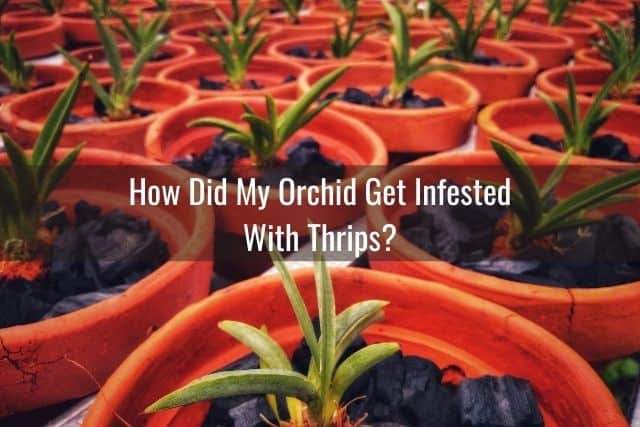
Thrips are one of the most common orchid pests out there. These pests are notoriously hard to control because they are winged insects. They can spread easily from plant to plant, carried by breezes and gusts of air.
This is most problematic in flower shops and supermarkets, as well as in greenhouses, due to circulating fans and plants clustered in close proximity. Pests can quickly spread from one infested plant to all the neighboring plants. Before you know it, you have a massive thrip infestation to deal with.
It should be noted that while thrips are a problem for orchid growers, these insects do not limit themselves to just orchids.
On the contrary, they can infest many other plants, such as roses, vegetable plants and other flowering plants. So, even if your entire orchid collection is thrip-free, they can still be at risk for a thrip infestation from outdoor breezes or a new plant that you bring into your home.
To reduce the chances that you’ll accidentally introduce thrips into your home, read Everyday Orchid’s guide on what to do with a new orchid first. This will outline what to do before adding your new orchid to the rest of your collection, such as isolating your orchid for several weeks and checking for pests and disease.
Be aware that thrips don’t have an “off-season.” While the life cycle is shorter in warmer weather, growers don’t get a break from these pests in cooler seasons.
On the contrary, thrips are active year-round. Always be on guard and regularly inspect your orchids for signs of thrips and other pests.
Can Thrips Spread To My Other Orchids?
Unfortunately, thrips can spread to your other orchids and household plants, and they can do this very easily.
Thrips are very mobile due to their wings and can easily move from plant to plant. This is why you need to take immediate action once you recognize a thrip infestation in one or more of your orchids.
Can Thrips Go Away On Their Own?
This is one of the situations where you might want to close your eyes and imagine that when you open them, the pests will be gone. But nope, that won’t happen here.
You do need to take action and manually treat the thrip infestation to make it go away. Leaving it alone won’t make it go away. On the contrary, that will just allow the thrip population to grow and continue to spread.
Left untreated, an orchid suffering from a thrip infestation will experience unslightly blemishes, bud blast, and damaged flowers at first. Then, the orchid will start to show stunted growth. Damage to the leaves and root tips will weaken and stress the orchid, leaving it vulnerable to other pests and diseases. If nothing is done about the thrips, the orchid will eventually die.
I’ve written another article on how to get rid of thrips on orchids, detailing various treatment options for dealing with a thrip infestation. In that article, I also talk about how to identify thrips and prevent future infestations. Please be sure to read it for more information on how to get rid of thrips.
Final Thoughts
As you now know, thrips can quickly cause widespread damage to an orchid if nothing is done to stop the infestation. Recognizing the signs of thrip damage are key to identifying a thrip infestation in the first place.
It is always a good idea to regularly inspect your orchids so that you can catch these types of pest infestations early on. I recommend doing daily, or at minimum, weekly inspections to check on and inspect your orchids. Focus on the flowers and undersides of the leaves to look for thrips and other orchid pests.
If you do have a thrip infestation, quick action must be taken to deal with the problem before serious damage is done to your orchid. Again, please read this guide on how to get rid of thrips on your orchid for more information.
If you enjoyed this article, please pin it and share!
